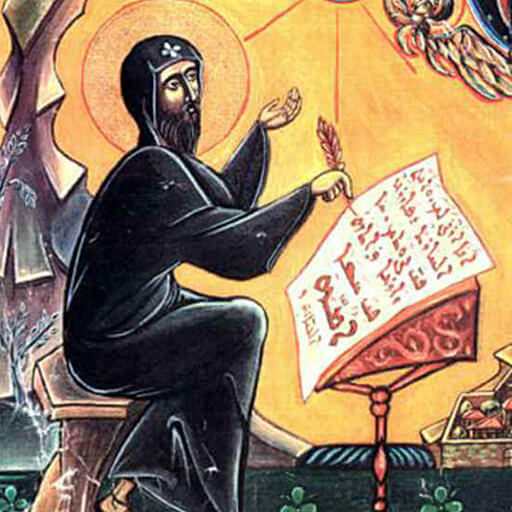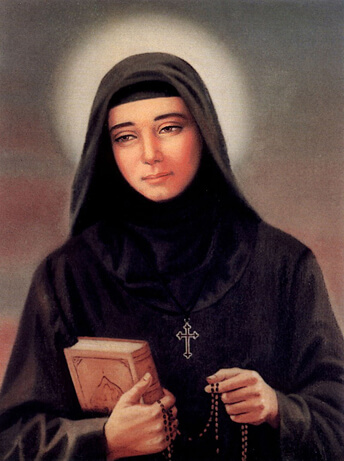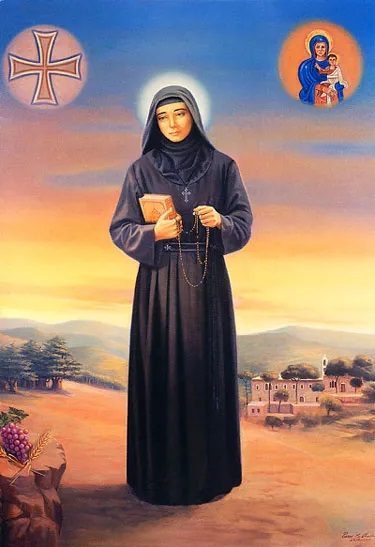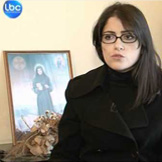SAINT RAFQA
St. Rafqa’s Biography
THE LEBANESE MARONITE NUN (1832 – 1914)
RAFQA in Himlaya (1832 – 1859)
She is like the lily of Himlaya
Grown as a bud in the land of Jrabta
And will grow thanks to the sky
The idea of Saint Rafqa’s basilica
Saint Rafqa was born in Himlaya, one of the villages of Northern Metn near Bikfaya, on June 29th, 1832.
She was the only child of Saber El-Choboq El Rayess and Rafqa Gemayel.
On July 7th, 1832, she was baptized and named Boutroussieh.
Her parents taught her to love God and pray daily. At the age of seven, she suffered her first great loss with the death of her mother.
In 1843, her father experienced financial difficulties and sent her to work as a servant for four years in Damascus in the house of Assaad Al-Badawi, of the Lebanese Nationality. Rafqa became a beautiful, pleasant, humorous young woman, pure and tender with a serene voice.
In 1847, she came back home to find that her father had remarried. His new wife wanted Rafqa to marry her brother. A conflict developed when her aunt tried also to arrange a marriage between her son and Rafqa.
So Rafqa asked God to help Her and clear Her thoughts. Thus, Her decision, to devote Her life to Jesus-Christ and to become a nun was Her greatest joy.
RAFQA in the Congregation of the Mariamettes (1859 – 1871)
At that time, Rafqa felt drawn in the religious life so she asked God to help her achieve her desire. She decided to go to the convent of Our Lady of Deliverance in Bikfaya. There, she joined the Mariamettes, founded by Father Joseph Gemayel.
When she entered the convent church, she felt deep joy and happiness. One look at the icon of Our Lady of Deliverance was enough to confirm God’s voice who told her to enter the religious life: “You will become a nun”. The Mother Superior accepted Rafqa without questioning her, she entered the convent, after that, she refused to go back home with her father and his wife, when they came to discourage her from becoming a nun.
Following a period of postulate, Rafqa wore the robe of novice related to the congregation on the feast of St. Joseph on March 19th, 1861. A year later and at the same date, she pronounced her temporary vows.
The new vower went to Ghazir’s Seminary where she was in charge of kitchen service. Among the seminarians were Elias Howayek, later to become Patriarch, and Boutros El- Zoghbi, later to become Archbishop.
Rafqa studied in her free time Arabic, calligraphy and arithmetic and also helped girls aspiring to join her congregation.
In 1860, Rafqa was sent to Deir El Qamar to teach catechism. There, she witnessed the bloody clashes that occurred in Lebanon during that period. On one occasion, she risked her own life by hiding a child under her robe and saving him from death.
After a year in Deir El Qamar, Rafqa returned to Ghazir. In 1863, she was sent to teach in a school of her congregation in Byblos. One year later, she was transferred to Maad village. There, with another nun, she spent seven years establishing a new school for girls, this was made possible through the generosity of Mr. Antoun Issa.
RAFQA in the Lebanese Maronite Order:
In the Monastery of St. Simon El Qarn in Aito (1871 – 1897).
While living in Maad and following a crisis in her congregation, Rafqa asked God to guide her to the right decision. Entering at St. George Church, to pray for help, she heard the Lord’s voice telling her: “You will remain a nun”. In the same night, she dreams and see St. George, St. Simon the stylit and St. Anthony the Great, the Father of monasticism. St. Anthony the Great told her: “Enter into the Lebanese Maronite Order”.
Her trip from Maad to the Maronite Monastery of St. Simon El Qarn in Aito was facilitated by the generosity of Mr. Antoun Issa. She was immediately admitted in the Order. She wore the novice robe on July 12th, 1871 and pronounced her solemn vows on August 25th, 1872. She chose the name “Sister Rafqa”, after her mother.
She spent 26 years in the monastery of St. Simon. She was a role model to the other nuns in her observation of the rules and her devotion to prayer and silence. Her life was full of sacrifice and austerity.
On the first Sunday of October 1885, she entered the monastery’s church and began to pray asking Jesus to permit her to experience some of the sufferings He endured during His Passion. Her prayer was immediately granted: Unbearable pain began in her head and moved to her eyes.
Her Superior insisted that she undergoes a medical treatment. After all local attempts to cure her had failed, she was sent to Beirut for treatment. Passing by St. John-Marcus Church in Byblos, her companions learned that an American doctor was in the area. So they took her to him. He ordered an immediate surgery for her right eye. St. Rafqa refused anesthesia. In the course of the surgery, the doctor uprooted by mistake her eye which fell on the floor. Rafqa did not complain and told him: “For Christ’s Passion, God bless your hands and may God pay you back”. Within a short time, the disease struck the left eye.
For the next 12 years she continued to experience intense pain in her head. Throughout this period, as before, she remained patient and uncomplaining, praying in joy for the gift of sharing in Jesus’ suffering.
In Saint Joseph Monastery Al Dahr in Jrabta-Batroun (1897 – 1914).
At Saint Simon’s monastery, lived sister Ursula Doumit who suffered from arthritis. Her doctors advised her to live near the coast. Sister Ursula’s brother, Fr. Ignace Doumit decided to found a monastery for nuns in Jrabta in the district of Batroun. Where the land for the project was donated by Fr. John Basbous.
On November 3, 1897, six nuns – presided by Mother Ursula Doumit – were sent to the new monastery of Saint Joseph, Sister Rafqa was among them. The other nuns were hopeful that the new monastery would prosper thanks to her prayers and the example she set.
In 1899, she lost the sight in her left eye and became paralyzed. With this, a new stage of her suffering began, intensified by the dislocation of her articulations. She spent the last seven years of her life lying on the bed, only on the right side of her body. She could not move. There was a very big injury in her left shoulder and she used to repeat: “For the wound in the shoulder of Jesus”. Her vertebras were visible through her skin and her body was very light. She became like a skeleton covered by skin. Her hands stayed intact; she used them to weave socks.
Although she was blind and paralyzed she kept smiling and thanking God for His grace of letting her participate in His Passion. Her face reflected peace and tenderness until the end of her days. According to some doctors, Rafqa suffered from an osteo-articular tuberculosis.
On a Thursday coinciding with the Day of the Holy Sacrament, Rafqa asked to be taken to church to attend mass.
However, she could not be carried out of bed as usual in a sheet because her left hip was aching that day.
When the mass started, everyone was struck with surprise to see Rafqa crawling into the church…
When later that day she was asked by the mother superior how she could drag herself to church, Rafqa replies that she only asked Jesus to help her, then she felt herself slip out of bed and she crawled to church.
Rafqa always asked the sisters not to forget the sixth wound of Jesus; the wound on his shoulder, the wound that caused a lot of pain because it carried the cross of our sins. Rafqa always prayed and recited the Pater and Hail Mary six times for the 6 wounds of Jesus.
Rafqa was 82 when she died. She had lived 29 years in suffering. On the 23rd of March 1914, supplied with the Holy Sacrament, she called upon Jesus, the Virgin Mary and St. Joseph, then she rested in peace after a life of prayer, service and years of unbearable pain. She was buried in the monastery’s cemetery. A splendid light appeared on her grave for three consecutive nights. With the intercession of St. Rafqa, Our Lord made lots of miracles and blessings.
On July 10th, 1927, her body was transferred to the monastery’s church. The case related to her beatification was submitted to the Vatican on the 23rd of December 1925 and the canonical investigation of her life began on May 16th, 1926.
Pope declarations concerning RAFQA
Pope John Paul II declared her:
Venerable on February 11th, 1982.
Beatified on November 17th, 1985.
A role model in the adoration of the Eucharist for the Jubilee Year 2000.
Saint for the whole Church on June 10th, 2001.
MIRACLES
Introduction
Rafqa returned to the soil where she was extracted, what was written in the bible was fulfilled: “Ashes to Ashes”, therefore, the soil on her tomb became light and life.
Three days after her death, her tomb shined with miraculous lights. The witnesses on that, were: Saleh El- Khoury from Maad, Durgham El- Khoury Khairallah and Shahine El- Farran from Sghar, a village facing the monastery of the monastery of St Joseph.
The first miracle made through her intercession, was with mother superior Ursula Doumit who was cured from an abscess in her neck after putting on it soil from Rafqa’s tomb.
Thousands of miracles poured: cure from cancer, cure from paralyses, cure from kidney and stomach diseases, cure from head diseases, cure from blindness, muteness, insanity and bleeding…
The news of her miracles spread, people came from everywhere to Rafqa’s tomb, asking for some soil, in order to get the blessing of curing.
1905-1914:
- She crawled, miraculously, to the church on the feast day of the Blessed Sacrament.
- She asked to see for an hour, and she enjoyed seeing the sisters and the monastery.
- She saw the heavenly glory in a state of ecstasy and vision.
- She chewed the Blessed Sacrament and stayed without eating for whole day.
- March 26th in 1914, her tomb glittered with miraculous lights.
- March 23rd 1914, Rafqa rested in peace, on Ash Monday.
- March 1938, Elizabeth Nakhleh El- Bathawi, from Torza, was healed of an uterus cancer. This miracle was adopted in the beatification case on November 17th.
First incident
This incident happened to Mother Ursula DOUMIT, Mother superior of Saint Joseph Monastery, Jrabta, only three days following Sister Rafqa’s decease on March 23rd, 1914.
Mother Ursula recounted:” I had a hazelnut- size pimple in my throat that somehow, bothered me why swallowing or talking, that lasted seven years.
Then I referred my case to a physician, Antoun KHAIRALLAH of Jran, who suggested that I apply some tincture of iodine to it. I promptly did, but this was nonetheless of no avail and it started growing bigger until it become as large as a big almond. Then, it protruded outward, causing me great pain that prevented me from swallowing or drinking, even milk.
Because of that, I started suffering from acute headache that compelled me one evening to go to bed earlier than usual and to ask the nuns to leave me alone to be able to have some sleep. While I was fast asleep, I heard a knock at my door; I woke up and asked, “Who is that?”
An outside voice replied, “Take some soil off Rafqa’s tomb and rub your throat with it, and then you will be healed”. Well, I thought it was one of the nuns who had knocked at my door and talked to me that way. Then I answered: “why don’t you just leave me alone to sleep?” but nobody replied. No sooner had I tried to resume my sleep, that I heard again, louder knocks at my door accompanied by a similar talk I had heard before. I thus replied that I would get the soil in the morning.
The next day, I asked each one of the nuns if she had knocked at my door and suggested that I get some soil…, but the answers were negative. However, I got some soil off sister Rafqa’s tomb, wondering what had happened to me, and dissolved it in some water and applied it to the pimple.
After that, the nun inquired, “how is your throat?” this made me instantly remember the above named incident, and impulsively stretch my hand to feel the pimple, but it was all gone, and I have been completely healed ever since!”
This incident and the mysterious voice inspired the nuns of the monastery to distribute, as a benediction, a handful of soil taken off St. Rafqa’s tomb. This soil became a source of grace and healing to all believers in God through the intercession of St. Rafqa.
Celine Sami RBAIZ
The miracle described below occurred in the Remail Region, Beirut with Celine Sami RBEIZ, she was born on May 10, 1983.
In October 1984, Celine Rbeiz found herself unable to eat or drink. As a result, she was hospitalized. Over the next six months, she experienced acute bleeding in her swollen stomach. She lost weight, becoming weaker and weaker. Tests eventually showed that her left kidney was damaged.
In September 1985, the kidney was removed. The pathology report indicated the presence of advanced cancer. Despite chemotherapy, the cancer spread to the liver.
Rapidly, Celine’s health deteriorated further. When her eyes and nose hemorrhaged, doctors concluded that she had no more than 24 hours to live.
Celine’s grandmother, Mrs.Yvette Daoo, had read a magazine article about the Blessed Rafqa. She was very moved by Rafqa’s story. Learning of Celine’s critical condition, she asked if she could have soil from the tomb of the “Saint that cures from cancer”. She believed the soil would heal Celine. Meanwhile, Celine’s mother, Mrs. Raymonda Daoo Rbeiz, had acquired a handful of this soil. On the evening of November23, 1985, Celine’s mother and grandmother added the soil to Celine’s food; and her mother said “this is the only medication for Celine.”
In fact, the soil used by Celine’s mother had been given to her by her neighbor, Mrs.Bernadette Kababeh Ibrahim. She had read a book entitled Rafqa: the six wound and had been very impressed by Rafqa’s life and miracles…She had gone with Fr.Salim Rizkallah, a Capuchin priest, and a group of pilgrims to celebrate mass on Rafqa’s tomb on Saturday, November 16, 1985, the night before Rafqa was beatified. At the time, she obtained the soil from Rafqa’s grave, which She later gave to Celine’s mother.
With difficulty, Celine ate the first spoonful. After few seconds, she felt her strength returning and ate the whole portion. One hour later, she recovered totally.
Mrs. Raymonda Daoo Rbeiz was astonished when she saw her daughter, Celine getting out of bed and walking in the hospital corridors…She knelt and said the rosary in honor of Blessed Rafqa and thanked Her for healing Celine.
Later, when the doctor examined her, he was stunned. “What did you do to the child?!!!” I can’t understand, this is impossible!!! Celine no longer needs an operation!!!”
He prepared to close Celine’s file. Mrs.Daoo Rbeiz said “I closed it with Saint Rafqa”.
Another doctor examined Celine and said “I am a believer and I practice my faith. In my opinion, Celine’s cure was a result of divine intervention, because it happened suddenly and quickly…”
Mrs.Yvette Daoo, Celine’s grandmother, insisted on Celine visiting St.Rafqa’s tomb. There she told her to repeat after her:” Saint Rafqa, I am Celine. I ask you to cure me”. All who were present and heard what she said started to cry…
Prayer through the intercession of St. Rafqa
O Jesus Christ, our God and Lord, you impressed St. Rafqa’s life so much that she became the teacher, the worker, the praying nun and your partner in the Mystery of Redemption. We ask you, through St. Rafqa’s intercession and prayers, to bless the children; to enlighten the youths; to transform people’s hard work and sufferings into blessings; to grant the graces of recovery, joy and happiness to sick people and to respond to the prayers of those, gathered in your name in churches and monasteries. O Lord as you graced Rafqa with eternal life’s blessings, allow us to live like her in faith, hope, and love so that we may glorify you and thank you with her and the Virgin Mary and all the Saints in heaven, forever and ever. Amen.
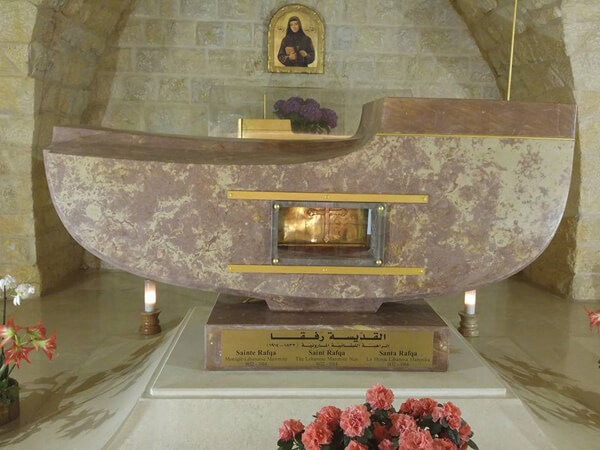
St. Rafka’s coffin
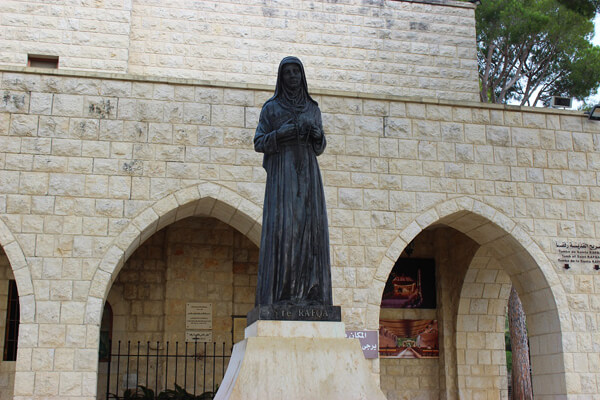
Saint Rafka Monastery, Jrabta – Lebanon
